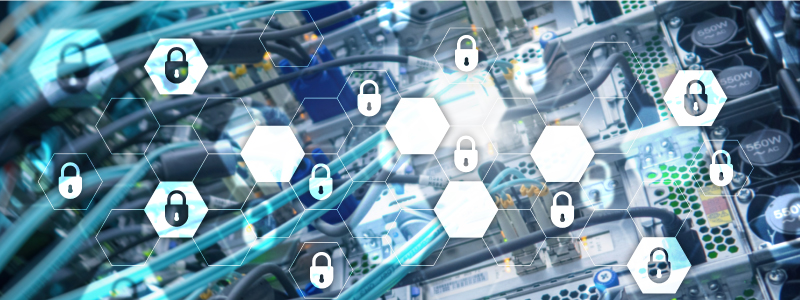Planning and Best Practices for Network Security in the Workplace
Ransomware, or malware, is one of the most profitable criminal business models in the history of malicious computer software. 2017 saw over 40,000 attacks per day, with ransomware hiding in over 40 percent of all email spam. In May of 2017, "WannaCry" Ransomware hit 150 countries by accessing employees' computers. In just one day, it infected more than 230,000 computers with an estimated loss of 4 billion dollars. New ransomware strains are hitting the cyber world continually, and Gartner predicted that by 2020, 60 percent of security budgets will be reserved for detection and response capabilities.
Some of Gartner's more recent predictions include:
- By the end of 2023, modern data privacy laws will cover the personal information of 75 percent of the world's population.
- By 2024, organizations that adopt a cybersecurity network architecture will be able to reduce the financial costs of security incidents by an average of 90 percent.
- By 2024, 30 percent of enterprises will deploy a cloud-based secure web gateway (SWG), cloud access security brokers (CASB), zero trust network access (ZTNA) and firewall as a service (FWaaS), sourced from the same vendor.
- By 2025, 60 percent of organizations will use cybersecurity risk as the primary determinant in conducting third-party transactions and business relationships.
TABLE OF CONTENTS
Planning and Best Practices for Network Security in the Workplace
What is Ransomware?
Phishing
Texting or SMS Phishing
Voice Phishing
Social Media
Ads and Images on Websites
How to Keep Up With Best Practices for Protecting Critical Information
Change Your Default Passwords
Begin Using Multi-Factor Authentication
Implement Business Continuity Plans That Include A Solid Backup Strategy
Schedule Penetration Testing On A Regular Basis
Adopt Zero-Trust Networking Principles
Implement Intrusion Prevention And Detection Systems (IPS/IDS)
Simplify Your Mobile Device Management
Extend Active Directory Servers To The Cloud
Utilize Port Scanning To Understand What You Are Exposing To Potential Attackers And Lockdown Unused Ports
Combating Network Security Threats
Truth, Disclosure and Transparency
Keeping Employees Safe
Multi-factor Authentication
Ongoing Cybersecurity Education
Protecting Customers
Network Security Challenges and How To Mitigate Risk for Distributed Enterprises
Keeping Hackers Busy
Value of Medical Records Skyrockets
Expansiveness of the IoT
Critical Next Steps for IoT Security
The Process for Patching Devices is as Important as Ensuring That Devices Can Be Patched
IoT Security Is Not One Thing – It Requires Defense in Depth
IoT Security Depends on IoT Solution Owners Following Security Best Practices
Nothing Can Be Made 100 Percent Secure, So We Need IoT Resiliency Too
What the New NIST Recommendations Mean for IoT Security
Consideration #1: Device Interactions with the Physical World
Consideration #2: Device Access, Management and Monitoring Features
Consideration #3: Cybersecurity and Privacy Capability, Availability, Efficiency and Effectiveness
Goal #1: Protect Device Security
Goal #2: Protect Data Security
Goal #3: Protect Individuals' Privacy
More to Come from NIST and Other Entities
How To Set Up A Secure IoT Network in Five Minutes or Less
Creating a Secure, Software-Defined Network for IoT
Customizing the Overlay Network
Additional Benefits of Software-Defined IoT Security
CJIS Security Policy Compliant Environments for Law Enforcement
Secure In-Vehicle Cloud Networking While Out in the Field
Criminal Justice Information Services (CJIS) Security Policy
Gigabit LTE Solutions and Cloud Networking
Cradlepoint Reference Architectures for CJIS Conformancy
What is Ransomware?
Ransomware is malicious software that locks or encrypted computer files, according to the security awareness training company KnowBe4. With the files “stolen away”, the organization must pay ransom in electronic currency to get those files back or to have the device unlocked. These ransoms can range from $500 to millions of dollars, sometimes with a looming one-week deadline, when the price starts to rise.
Once the fee is paid, the cybercriminal provides the key to unlock or decrypt the stolen computer files. Ransomware can even get past an employee's workstation and work its way across a company's entire network, and encrypt all the files in its path. Unfortunately, cybersecurity threats will see a substantial rise in 2023, according to Gartner. Organizations need to stand alert and be prepared for these potential threats. Here are a few strategies businesses can take to increase network security.
Understanding potential ransomware threats and educating employees is the first step in fighting against cybercriminals. Ransomware could infect employee's computer files in a variety of ways, including:

Phishing
Texting or SMS Phishing
Voice Phishing
Ads and Images on Websites

How to Keep Up With Best Practices for Protecting Critical Information
Security challenges among network administrators and security specialists continue to persist. The ever-expanding presence of workforce mobility, the Internet of Things, and more makes keeping up with the latest security best practices more critical.
Here are 10 crucial network security needs:
Change Your Default Passwords
Network manufacturers usually ship devices with default passwords. If you still haven't changed the default password, your network is vulnerable to hackers.
Begin Using Multi-factor Authentication
With multi-factor authentication, even attackers armed with stolen usernames and passwords wouldn't have enough information to log in. Layered network security practices such as multifactor authentication mitigate the risk of data breaches.
Implement Business Continuity Plans That Include A Solid Backup Strategy
Schedule Penetration Testing Regularly
Adopt Zero-Trust Networking Principles
Implement Intrusion Prevention And Detection Systems (IPS/IDS)
Simplify Your Mobile Device Management
Extend Active Directory Servers To The Cloud
Utilize Port Scanning To Understand What You Are Exposing To Potential Attackers And Lockdown Unused Ports

Combating Network Security Threats
A handful of people know that October represents more than just a time dedicated to jack-o-lanterns, costumes, and Halloween lore. October is also the month chosen by the Department of Homeland Security (DHS) and the National Cyber Security Alliance (NCSA) to raise awareness about the importance of cybersecurity. The effort is meant to inspire people throughout the country to be safe and secure online. The overarching theme of this initiative is to encourage the idea that cybersecurity is a shared responsibility; everyone should be aware of the risks and use good judgment while online to combat the ongoing threat of phishing attacks, malware, and other security breaches year-round.
Cradlepoint (one of USAT's top manufacturing partners) follows the shared responsibility model inspired by the DHA and NCSA closely by making truth, disclosure, and the transparency of known vulnerabilities foundational pillars in our security operations.
Truth, Disclosure, and Transparency
Keeping Employees Safe
According to PhishMe, 91 percent of cyberattacks start with a phishing email. The emails are designed to trick employees into clicking an infected link or opening an infected attachment. The email will usually look like it's from an organization that the employee would recognize and assume was real.
Additionally, according to Verizon's 2018 Data Breach Investigation Report, pretexting is a similar social attack but is somewhat more involved. In this scenario, the criminal emails, calls or even visits an employee in person and engages them in conversation to fool the victim into providing the attacker with credentials, or other sensitive data, with which they can launch an attack.
Cradlepoint focuses on a few different methods to help our employees stay educated and aware of cybersecurity, such as mandatory education every year for security awareness training and multifactor authentication.
Multi-factor Authentication
With the increasing value of usernames and passwords on the black market, multifactor authentication is an underrated end-user security strategy. By requiring users to present two pieces of identification — one being something you know (a username or password) combined with something you have in your possession (authentication code on your phone) — at each login, multi-factor authentication provides an added layer of safety even if employees credentials are compromised.
As more and more enterprises move toward digital transformation, an inevitable process for successful business models, network security is becoming a top priority. From network architecture to end-user caution, it takes a variety of diligent efforts to keep an enterprise network secure.
Verizon's Data Breach Investigation Report backs the value of multifactor authentication and describes the use of default or easily guessable passwords "as popular as tight rolling your jeans." The report expresses that no matter who administers a company's POS environment (whether in-house or outsourced), they should be required to use two-factor authentication.
Ongoing Cybersecurity Education
Protecting Customers
Protecting applications, collaboration, and connected technologies across an ever-expanding network attack surface is essential for IT organizations. A modern mobile network solution must provide comprehensive edge security capabilities that protect local users and endpoint devices, the WAN, and cloud communications with access controls, FIPS-certified data encryption, IoT device isolation, and Internet threat management.
Cradlepoint has partnered with the best-in-class cloud security providers, Z-Scaler, and Webroot, to provide Internet security, leveraging URL filtering, and blocking of web-based threats, including malicious content, botnets, advanced persistent threats, browser exploits, and phishing attacks.
Customers may also utilize Parallel Networks — or "air-gapped" networks — with secure LTE routers. This strategy keeps critical applications holding sensitive data physically separated from noncritical applications to help mitigate the risks of pivot attacks. Many high-profile data breaches in recent years were pivot attacks, where hackers breached an easily accessible part of the network and then moved into an area where sensitive data was stored.
From network architecture to end-user caution, it takes various diligent efforts to keep an organization's network secure.

Network Security Challenges and How To Mitigate Risk for Distributed Enterprises
Let's take a look at three aspects of security that are scary but not impossible:
Keeping Hackers Busy
With the steady increase of applications and devices requiring connectivity, and considering the maturation of hacking strategies, some of the largest companies in the world are realizing how difficult it is to completely prevent hackers from entering their networks. While security-driven network architecture to prevent breaches is significant, so is getting them off the network once they enter.
Security and IT managers at large companies realize that with savvy adversaries worldwide, detection and confusion are increasingly vital. Managers can keep potential attackers busy by fixing vulnerabilities as quickly as possible, isolating networks, changing firewall rules, moving files around, and constantly putting new controls in place — and by doing this consistently.
Even so, these defensive tactics haven't displaced the need for proactive security efforts. Strategies such as Parallel Networking with Cradlepoint's 4G LTE solutions physically isolate the corporate network on which Point-of-Sale and other sensitive data reside.
Value of Medical Records Skyrockets
Not that long ago, it was a given that credit card information was the most sought-after data for hackers. Today, healthcare records have become the highest-value target.
A year ago, Reuters reported that medical information costs 10 times more than a credit card number on the black market. The malicious activity includes using names, birth dates, policy numbers, diagnosis codes, and billing information "to create fake IDs to buy medical equipment or drugs that can be resold, or they combine a patient number with a false provider number and file made-up claims with insurers," according to the report. Also, theft of medical records usually isn't reported nearly as quickly as credit card fraud, which makes this type of data even more valuable.
If a company with 100 employees stores all of its valuable employee healthcare records on a USB drive inserted into various managers' computers, the risk for malicious activity is high. Once medical records are stolen, the adverse effects on both employees and the company can be extensive and last for years.
Expansiveness of the IoT
The sheer number of connected devices is truly staggering. Gartner estimates that 15.14 billion connected things will be in use in 2023.
In a branch store, the IoT could encompass a wide variety of things, including:
- point-of-sale machines
- digital signage
- security system and surveillance cameras
- breakroom refrigerator, toaster, coffee maker, and vending machines
- printers
- HVAC system
- lighting controls
- visitor WiFi
- … and more.
Out in the field, the scope of the IoT is even more vast. Wearables allow fire departments to monitor the location and physical well-being of firefighters. Cities monitor everything from traffic patterns to plowing progress during snowstorms. Industrial systems can be controlled and analyzed from a single remote location.
No one strategy or solution will keep networks secure and protect distributed enterprises. Companies can do their best to mitigate risk by educating employees, opening the lines of communication between staff and the IT department, engaging in penetration testing, and more. Cradlepoint contributes to the cause of best-in-breed security and cloud management solutions.
Even amid ever-expanding network threats, we can work together to protect the sensitive data entrusted with us.

Critical Next Steps for IoT Security
A Washington Post article published in 2018 discussed how security researchers at that year's Black Hat USA conference continue to be concerned about IoT security. The article included these researchers' advice to policymakers in Washington (including the bipartisan list of Senators working on new IoT security legislation) on what they need to understand about the IoT and cybersecurity as they move forward in developing and implementing policies designed to make the IoT more secure.
The points highlighted in the article are important for policymakers to understand as they move forward – that more cyber attacks are coming, IoT devices need to be patchable, smart cities are vulnerable, and security researchers are your friends. However, there are also a few more issues I would recommend that policymakers – as well as IoT devices, manufacturers, solution developers, and customers – should learn more about as we work together to increase IoT security and resiliency by enhancing solutions and promoting improved IoT device security best practices.
The Process for Patching Devices is as Important as Ensuring That Devices Can Be Patched
Today, most IoT gateways, modules, and other connectivity devices can be upgraded with new firmware to fix security vulnerabilities as they emerge. However, without proper planning, it may be difficult, impossible or too expensive to deploy these patches to thousands or millions of devices in the field, resulting in critical gaps in IoT device security.
Local updates are costly because they require a technician to visit each device. Over-the-Air (OTA) updates are more scalable but require investment in a network management solution. OTA updates can also consume a lot of bandwidth, making it very expensive if, for example, the devices are deployed with a data plan only allowing 5MB/month while each security update is several times that size.
Even if bandwidth is not a concern, power might be. Battery-powered devices designed to last for years (because they transmit and receive very little data) can have their entire power reserves depleted by a single security update, necessitating expensive technician visits to replace batteries or the devices themselves. In some cases, so-called "Deep Edge" devices, which live in fringe coverage areas or deep inside buildings or underground, may achieve data rates only in the hundreds of bits per second, making a multi-megabyte download impossible. There are solutions to these issues, but they may require policy changes, the deployment of new technologies, and changes to the business models of IoT market participants.
Some out-of-the-box thinking is needed. For example, mobile network operators could be required to provide customers free or discounted bandwidth for security updates. Another possibility is that operational workflows could be utilized to update firmware through local interfaces where OTA updates are not feasible. For example, smart lighting firmware could be updated when changing a bulb. Perhaps sensors deep inside buildings could be updated over Wi-Fi utilizing a distribution server in a janitor's cart.
In addition, a Defense in Depth strategy as discussed below may offer sufficient protection for some use cases, eliminating the need for many firmware updates.
IoT Security Is Not One Thing – It Requires Defense in Depth
Defense in Depth improves IoT security by forcing an attacker to breach multiple security layers to compromise an IoT solution. When a vulnerability is detected in one layer, the other layers protect the integrity of the system until the breach can be detected and contained and the vulnerability can be corrected. For example:
- A private cellular gateway called an Access Point Name (APN), implements a network-level firewall restricting the hosts that can reach a device.
- A device firewall performs the same function in the event an attacker can penetrate the private APN.
- Using secure authentication on the services the firewall needs to leave accessible ensures that only authorized users may connect, creating another obstacle should an attacker compromise a device permitted to traverse the APN and device firewalls.
- Role-based access privileges limit what can be seen and done should an attacker compromise the credentials of an authorized user on a device permitted to traverse the APN and device firewalls.
- Up-to-date firmware helps ensure there are no vulnerabilities that allow attackers to bypass role-based access privileges.
- Cloud management and network operations platforms monitor device behavior for anomalies that may indicate an attacker has compromised the IoT device's security despite all the above protections.
IoT Security Depends on IoT Solution Owners Following Security Best Practices
Even the most robust safe will not stop a robber if the owner forgets to lock it. IoT devices, networks and cloud software can be built using the world's best security technologies. Still, users need to take advantage of these IoT security solutions by following best practices to ensure overall security is maintained.
However, even here, some responsibility falls to the IoT device, network, and cloud software providers. In addition to integrating security technologies into their products, they should not assume users will always follow security best practices. Instead, they should ensure their devices, networks and software are "secure by default."
For example:
- Devices should use cryptographically secure unique random default passwords instead of global shared passwords. This enhances security should users not change the default password.
- Device firewalls should default to blocking all traffic on network interfaces to force users to properly configure devices before use – and to protect the device should it be turned on and connected to the network using default settings.
- All non-essential services and/or ports should be disabled by default to minimize the attack surface should the device be deployed in its default state or reset to defaults in the field.
Still, there is only so much that IoT device, network, and cloud software providers can do. A strong security posture is possible only if IoT solution owners and users follow security best practices. How can we increase IoT owners and users' adoption of security best practices?
The most important step is education and training. One possible strategy involves Computer Assisted Training materials. These could be developed by vendors or a group of security experts and provided for free (or minimal expense) to customers. After a user completes the training, a security "certificate" could be issued and kept on file by the user's organization.
Nothing Can Be Made 100 Percent Secure, So We Need IoT Resiliency Too
Even if IoT solutions use devices that are patched with all the latest security updates, have security deployed in-depth, and have users who are carefully following security best practices, there is still the possibility that the solution could be hacked – if not by an external threat actor, then by an internal one. Given this reality, developers, users, and owners of IoT solutions need to plan for the worst – that, in the future, their solution will be hacked, despite all their efforts. This means they must have a resiliency strategy to recover from the attack as quickly and comprehensively as possible.
This could involve backing up data from their IoT solutions, so that, if necessary, they can wipe the devices and then restart them with the backed-up data. In addition, IoT solutions used in mission-critical applications, such as for first responder communications or the control of critical infrastructure, failover systems should be deployed to take over in the event the primary system is compromised.
We hope that policymakers and IoT device manufacturers, solution developers, and customers will consider these issues while offering their ideas on how to work together to make the IoT more secure. While some may think discussions sow fear that slow the growth of the IoT, we believe that we need to be open about IoT security and constantly be working to improve it – because good security is foundational to the success of the IoT.

What the New NIST Recommendations Mean for IoT Security
The security of IoT devices and data is one of the hottest topics for enterprise businesses — and one that has been lacking definitive guidelines, awareness, and standards for some time. Recently the National Institute of Standards and Technology (NIST) released a document that begins to fill this noticeable gap by helping everyone understand how to analyze various risks and threats to better plan and manage IoT devices in the enterprise.
NIST will provide more prescriptive guidance based on specific industries soon, but for now, the organization's "Considerations for Managing Internet of Things (IoT) Cybersecurity and Privacy Risks (NISTR 8228)" outlines a few vital topics that everyone who has deployed or is considering deploying IoT applications should consider. These are mainly centered on differences between IoT devices and your typical IT endpoints.
Below are three considerations from NIST when adopting IoT. One of the significant differences in managing risk with IoT compared to IT systems is that IoT typically focuses heavily on protecting the confidentiality of data. Also, IoT use cases are more about availability and integrity because of their interactions with the physical environment.
Consideration #1: Device Interactions with the Physical World
Consideration #2: Device Access, Management, and Monitoring Features
Consideration #3: Cybersecurity and Privacy Capability, Availability, Efficiency, and Effectiveness
The availability, efficiency, and effectiveness of cybersecurity and privacy capabilities for IoT devices often differ from conventional IT devices. Many IoT solutions and use cases are very price sensitive in order for them to make business sense to deploy. As a result, IoT devices typically do not have security features or secure development models integrated into their solutions. Using existing network-based security solutions may not be sufficient due to proprietary and different IoT protocols and the IoT devices' ability to communicate directly over RF protocols such as BLE, WiFi, LoRAN, ZigBee, Zwave, LTE, and more.
NIST recommends the following three risk mitigation strategies be layered into your security operations. Each one builds upon the previous goal:
Goal #1: Protect Device Security
Goal #2: Protect Data Security
Goal #3: Protect Individuals' Privacy
More to Come from NIST and Other Entities
This initial step by NIST is only the beginning. IoT security will remain one of the most crucial enterprise security issues for many years, as evidenced by the amount of activity surrounding it. From U.S. and overseas lawmakers to cellular operators and many other companies and groups, expect a steady onslaught of opinions and guidelines.
NIST has built upon this foundational report by developing recommendations on "the appropriate use and management" of IoT devices "owned or controlled by the Federal Government."
Fortunately, industry consortiums, governments, and standards bodies are aggressively trying to mature the state of IoT security for everyone. Here are a few to note:
- In November 2018, the International Organization for Standardization (ISO) released a reference framework for the Internet of Things (IoT): ISO/IEC 30141.
- In October 2018, the UK government published the "Code of Practice for Consumer IoT Security" developed by the Department for Digital, Culture, Media, and Sport (DCMS), in conjunction with the National Cyber Security Centre (NCSC) for Consumer IoT Devices.
- In February 2019, the Technical Committee on Cybersecurity (TC CYBER) released a cybersecurity standard for consumer IoT devices and basis for certification for IoT certifications: ETSI TS 103 645.
- In October 2018, CTIA published an "IoT Cybersecurity Certification" program for cellular-connected IoT devices.
- In September 2018, The State of California passed a bill for minimum security capabilities: SB-327 Information privacy: connected devices.
- The GSMA (a global mobile operator consortium) has published the IoT Guidelines and Assessment to help promote best practices for IoT solutions.
In terms of accountability to security standards, the IoT landscape has a long way to go. However, a path has been forged.

How To Set Up A Secure IoT Network in Five Minutes or Less
The widespread IoT deployments have created a perfect storm of needs and challenges. The seemingly limitless opportunities for enterprises to collect and leverage data, streamline business operations, and even improve customer service is difficult to ignore. At the same time, the process of connecting, managing, and securing IoT devices and data that are located all over the world comes with daunting challenges.
Most organizations need more IT staff to monitor, manage, and troubleshoot the connectivity and security of IoT devices that are broadly distributed across many branches, fleet vehicles, or in the wild.
Also, traditional TCP/IP transport protocol could be better for IoT. For one thing, IP is a "connect first, authenticate second" protocol, which exposes devices and networks to outside influence. Also, micro-segmentation with IP is cumbersome and complex, requiring additional protocols that can lead to more errors and can hinder security due to human error. Lastly, security solutions for IoT are few and far between due to the computing power and memory on the devices.
The biggest challenge is that IoT data should be completely separated from sensitive data, such as Point-of-Sale information, and other networks, including the corporate WAN, so that if a system is compromised, the intruder can't hop over to another network.
These challenges call for overlay networks that can connect IoT devices and the cloud and utilize a secure private IP address space. Cradlepoint's NetCloud Perimeter (NCP) service, using Software-Defined Perimeter technology, enables IT teams to set up perimeter-secured overlay networks with just a handful of simple steps that can be completed within a matter of minutes.
For example, let's envision a common scenario in a branch office or a connected fleet vehicle: An IT professional needs to secure various IoT devices connected on the network behind a router.
With NCP running as a configured service on a Cradlepoint router — turning the router into a NetCloud Gateway — LAN-connected devices such as digital signs, surveillance cameras, and more can be placed on an overlay network that isolates IoT data from the Internet and other networks. Behind a NetCloud Gateway, any IP-based device can be connected to the overlay network without additional software.
These overlay networks provide a cloud-based VPN alternative for IoT use cases and those who interact with them. They can be created, configured, and scaled cost-effectively in just a few minutes.
Creating a Secure, Software-Defined Network for IoT
- From the NetCloud DASHBOARD, Select the NETWORK menu.
- Click "Add."
- Enter "Network Name," then click "Create new network."
- Within a few moments, the new network will appear in the list of networks.
- Turning a Router into a NetCloud Gateway
- In Cradlepoint's NetCloud Manager, it takes 5 minutes or less to begin running NCP on a specific router:
- Find a router (in the DEVICES tab).
- Click the commands to "Upgrade NetCloud Gateway" on the chosen device.
- Select the desired overlay network.
- Select the specific LANs associated with this router that need NCP access.
- Select "Auto-Whitelist" to automatically assign an overlay network IP address to every device on that network.
- Click "Save" to complete NetCloud Gateway installation.
- Select the NETWORK menu, then click on the overlay network. The router with the NetCloud Gateway installation will appear in the devices list with a green circle and a white checkmark.
For a more extended, more detailed version of this process, explore our related NetCloud Perimeter articles in Knowledge Base.
Customizing the Overlay Network
- From the NETWORKS page, click the overlay network that you want to configure.
- Click the "Settings" tab.
- Change the default subdomain name to a custom DNS name that accurately describes the network.
- Adding IoT Devices to the Network
- Once a NetCloud Gateway is in place, IT staff can find and define a group of IoT devices to connect to that gateway via the NetCloud dashboard. These could include devices (Windows, MAC, Linux, iPhone, Android, and docker) running the NetCloud Client software and those without the software that resides on the network behind a NetCloud Gateway.
Once devices have been added to an overlay network, additional NCP features can be utilized, such as micro-segmentation and other security policies.
Additional Benefits of Software-Defined IoT Security
One of the most important benefits of NCP is that enterprises can micro-segment users, devices, groups, applications, and resources with simple policies, as well as offer LAN-like performance to remote users on virtually any device in a matter of minutes — without complex configurations.
These invitation-only overlay networks are highly secure, as they utilize a private address space — eliminating the need for routable IPs on the Internet — thus obscuring them from potential hackers.

CJIS Security Policy Compliant Environments for Law Enforcement
Secure In-Vehicle Cloud Networking While Out in the Field
Criminal Justice Information Services (CJIS) Security Policy
The Criminal Justice Information Services (CJIS) Security Policy was designed to protect criminal justice information (CJI); for this reason, agencies must conform with CJIS Security Policy within their agency operations. CJIS Security Policy keeps CJI safe by providing a minimum set of security requirements for access to CJI stored on FBI systems. The main idea of the CJIS Security Policy is to provide the appropriate methods to protect CJI from unauthorized disclosure —from creation through dissemination, whether it is being stored or transferred.
With this duty in mind, many law enforcement agencies question whether sensitive data remains secure and if they can comply with CJIS Security Policy while transferring and storing data digitally or utilizing the cloud. The answer to this question is yes because the CJIS Security Policy is device and architecture-independent. For example, Cradlepoint's network management service, NetCloud, is only concerned with securely transporting and storing router management data. No customer network data, including CJI, encrypted or otherwise, is sent to NetCloud.
Gigabit LTE Solutions and Cloud Networking
Agencies can leverage and manage Cradlepoint's secure, Gigabit LTE router solutions that conform with CJIS Security Policy guidelines to easily extend and manage network connectivity to their policing vehicles, stations, and surveillance locations. Cradlepoint's solutions and NetCloud Service can also deliver significant ROI by reducing IT overhead costs, minimizing network downtime, and maximizing the effectiveness of law enforcement activities.
Cradlepoint's solutions are designed with security in mind. They include advanced security protections like intrusion detection and prevention, content filtering/anti-malware protection, IPSec VPN, private LTE networks, activity logging and alerting, FIPS 140-2 certified cryptographic modules, integrated permission management, and SD-WAN features to maximize uptime.
Cradlepoint also delivers purpose-built networks for branch, mobile vehicle, and IoT, and can manage all use cases in a single service — assisting lean IT teams. To remain CJIS conformant, law enforcement also must have secure connectivity within their vehicles. CJIS Policy requires that any enclosed mobile vehicle — where law enforcement conducts most of their work on devices such as Mobile Data Terminals/Computers (MDT/MDC) — with an in-vehicle network connection must ensure data that is stored or transferred is safeguarded.
Cradlepoint Reference Architectures for CJIS Conformancy
To help law enforcement achieve these measures, Cradlepoint has identified reference architectures that allow law enforcement to utilize secure connectivity inside their vehicles to access applications, such as Computer-Aided Dispatch (CAD), Automatic Vehicle Location (AVL), or any application that stores and transfers data and remain CJIS conformant.
One reference architecture leverages the Cradlepoint routers, including a FIPS-validated cryptographic module built into NetCloud Operating System (NCOS). Cradlepoint FIPS routers are compatible with most VPN head-end routers/firewalls and support most major routing protocols. A site-to-site or spoke-to-hub VPN network connection can be established by configuring VPN connections between the law enforcement in-vehicle network and the Cradlepoint router.
In another reference architecture scenario, law enforcement agencies that use Cradlepoint devices may also deploy VPN clients on their MDTs. Most MDT manufacturers include FIPS-certified modules within their products, this restricts the requirements of the CJIS Security Policy solely to the MDT, mitigating the need for a FIPS validated router and minimizing exposure of the agency's internal network to only the MDT itself.
Cradlepoint has a long and successful track record of customers using Cradlepoint routers and NetCloud Service for securely transporting a wide range of sensitive federal, state, and local government workloads, including CJI data. Law enforcement customers (and partners who manage CJI) utilize Cradlepoint Gigabit LTE-enabled routers and NetCloud Service to easily extend and manage secure network connectivity to their policing vehicles, stations, and surveillance locations while maintaining CJIS compliance.
About USAT
For over 25 years, USAT has provided mobile communications solutions for various retail and branch applications across the USA. With our extensive catalog of world-class routers, gateways, and software (from manufacturing partners like Cradlepoint) designed for remote monitoring and management in even the harshest environments — you can count on us to get and keep you connected.
Better mobile connectivity translates to less manual equipment maintenance, reduced downtime, and an overall increase in your business's ROI. Contact the experts at USAT to learn how our wireless networking solutions can help meet your organization's exacting needs.
Share this Post















Social Media